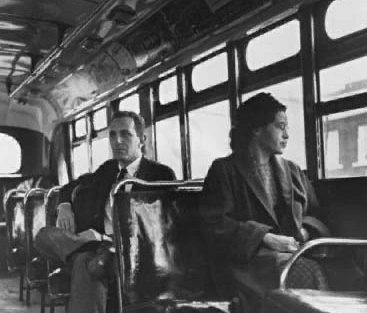Rosa Parks.
Publié le 10/05/2013
Extrait du document

Rosa Parks. Rosa Parks (1913-2005), African American civil rights activist. In 1955 in Montgomery, Alabama, Parks refused to give up her bus seat to a white man. Her action led to the Montgomery bus boycott, an organized, citywide protest against segregation that used nonviolent tactics. Rosa Parks's personal act of defiance opened a decisive chapter in the civil rights movement in the United States. Rosa Louise McCauley was born in Tuskegee, Alabama. She was raised by her mother, Leona McCauley, on her grandparents' farm at Pine Level, a small community outside Montgomery. Rosa received her primary education in a segregated rural school. In 1924 she enrolled at the private Montgomery Industrial School for Girls, known as 'Miss White's School' after its principal and cofounder, Alice L. White. All the students were African Americans, and all the teachers were white women from the North. 'What I learned best at Miss White's school," Parks later wrote in her autobiography, Rosa Parks: My Story (1992), 'was that I was a person with dignity and selfrespect, and I should not set my sights lower than anybody else just because I was black.' As a teenager she attended Booker T. Washington Junior High School in Montgomery and participated in a high school program at State Teachers College (now Alabama State University). She dropped out at the age of 16 to care for her grandmother, who died soon after, and then for her ailing mother. In December 1932 she married Raymond Parks, a 29-year-old barber. Rosa Parks received her high school diploma the following year and helped support the family by sewing and doing other jobs. Parks's husband had long been active in the National Association for the Advancement of Colored People (NAACP), an organization founded to improve the conditions for blacks in the United States. Parks became increasingly committed to racial justice as she and her husband joined the campaign to save the 'Scottsboro Boys'--nine young black men who were accused of raping two white teenagers near Scottsboro, Alabama, in 1931. An all-white jury convicted the nine boys of the crime and sentenced eight of them to death, despite strong evidence of their innocence. All of the Scottsboro Boys eventually gained their freedom, but the process took nearly 20 years. See Scottsboro Case. In 1943 Rosa Parks became secretary of the Montgomery branch of the NAACP. That year, she made her first attempt to register to vote, although she did not succeed until her third try, in 1945. She also had her first dispute with a local bus driver when she tried to defy a rule that required blacks to board buses from the back door. A turning point in her life and in the history of the struggle for racial equality occurred on December 1, 1955. Parks was riding home from work on the Cleveland Avenue bus line in Montgomery when she refused to give up her place in the front row of the 'colored section' to a white man who could find no seat in the section reserved for whites. Her refusal to move to the back of the bus defied local ordinances and Alabama state statutes requiring segregation in public transportation. The driver called the police, and Parks was arrested, jailed, and eventually convicted of violating segregation laws. She was fined $10, plus $4 in court costs. The black community in Montgomery was outraged by the case and organized a bus boycott that began as a one-day demonstration. But the boycott lasted 381 days in all, with nearly unanimous support from the 50,000 African Americans in Montgomery. Protesters formed an organization called the Montgomery Improvement Association (MIA) under the leadership of Dr. Martin Luther King, Jr., a minister who had recently moved to the city. The MIA urged sympathizers not to ride on Montgomery's segregated buses and helped them find other means of transportation. In November 1956 the Supreme Court of the United States upheld a federal court decision ordering the Montgomery buses desegregated. The order took effect the following month, ending the boycott. See also Segregation in the United States. The Montgomery boycott was successful and brought King to national attention. It also inspired other civil rights protests around the South, such as sit-ins at segregated restaurants. However, both Rosa and Raymond Parks lost their jobs and suffered repeatedly from harassment and threats. In August 1957 the couple moved to Detroit, Michigan. They had difficulty finding work during their first years in Detroit. Rosa Parks took in sewing and worked as a fundraiser for the NAACP. In 1965 Democratic congressman John Conyers, Jr., hired her to work in his Detroit office. Parks remained on his staff until her retirement in 1988. Rosa Parks remained active in the NAACP and in other civil rights organizations, including the Southern Christian Leadership Conference (SCLC), until advancing age slowed her down. She received numerous awards and tributes, including the NAACP's highest honor, the Spingarn Medal, in 1970 and the prestigious Martin Luther King, Jr. Award in 1980. Cleveland Avenue in the city of Montgomery was renamed Rosa Parks Boulevard in 1965. In 1987 she founded the Rosa and Raymond Parks Institute for Self Development, which provides scholarships and guidance for young blacks. In 1996 President Bill Clinton awarded her the Presidential Medal of Freedom, the highest honor that the U.S. government can give to a civilian, and in 1999 she received the Congressional Gold Medal from the Congress of the United States. In January 1999 President Clinton invited Parks to sit with Hillary Rodham Clinton during the annual State of the Union address. During the speech President Clinton recognized the contributions of Parks, who received a standing ovation from the audience. Reviewed By: Paul Finkelman Microsoft ® Encarta ® 2009. © 1993-2008 Microsoft Corporation. All rights reserved.
Liens utiles
- la dignité de Rosa Parks
- Rosa Parks
- rosa parks notion myth et hero
- Rosa Parks
- Rosa Louise Parks - biography.































